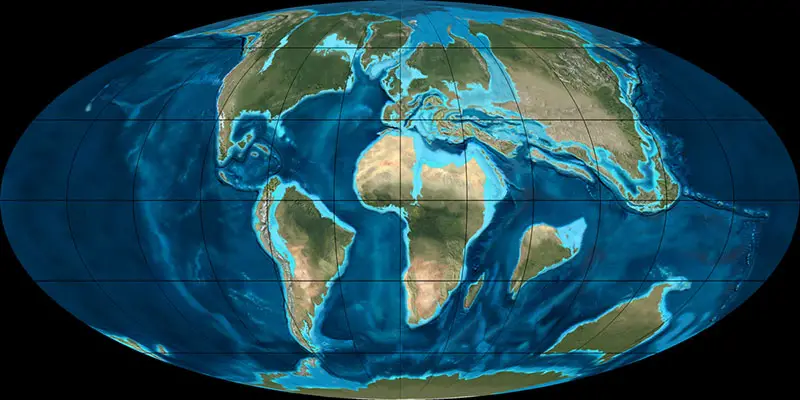†Niptomomys (Microsyopidae)
Niptomomys ist eine Primatengattung innerhalb der Familie Microsyopidae, deren 4 Mitglieder ab dem frühen Paläogen (Paläozän) im Thanetium lebten, das vor ungefähr 59,2 Millionen Jahren begann und bis vor 56 Millionen Jahren andauerte. Viele Überreste wurden in Vereinigte Staaten von Amerika (USA) gefunden.
Die Gattung Niptomomys innerhalb der Familie Microsyopidae (Unterfamilie Uintasoricinae) ist durch drei Arten repräsentiert, die vom späten Paläozän bis ins frühe Eozän in Nordamerika verbreitet waren.
Niptomomys doreenae
Das Typusexemplar stammt aus dem Kent Steinbruch in Colorado (Wasatch Formation) und ist zwischen 55,4 und 50,3 Millionen Jahre alt. Es wird an der University of California, Museum of Paleontology aufbewahrt. Niptomomys doreenae war ein baumlebender Allesfresser. Basierend auf der Größe und Morphologie der Backenzähne schätzen Wissenschaftler sein Körpergewicht auf 50,7 Gramm.
| Sammlung | Epoche, Alter | Kommentar zur Sammlung |
|---|---|---|
| Holly's Microsite | SC-188 | |
| Museum | Kommentar z. Taxonomie | |
| UMMP | meter level said to be 1280 m by Gunnell and Gingerich 1991 and appears to be 1260 m in fig. 3 |
Niptomomys favorum
Das Typusexemplar stammt aus Castle Gardens (Willwood Formation) im Washakie County, Wyoming und ist zwischen 55,4 und 50,3 Millionen Jahre alt. Der Fund wird an der University of California, Museum of Paleontology aufbewahrt.
| Physiologie | |
|---|---|
| Gewicht: | ? |
| Schwestertaxa | |
Niptomomys thelmae
Das kleine Säugetier war ein baumlebender Allesfresser. Basierend auf der Morphologie seiner Backenzähne schätzen Wissenschaftler sein Körpergewicht auf 71,0 Gramm. Exemplare von Niptomomys thelmae stammen aus der Willwood Formation Wyomings (USA) und sind zwischen 55,4 und 50,3 Millionen Jahre alt.
| Sammlung | Epoche, Alter | Geologie, Formation | Kommentar zur Sammlung |
|---|---|---|---|
| Elk Creek (610 m) | Willwood | YPM 174, 175, 176, 185, 191, USGS D-1567 | |
| Kommentar z. Taxonomie | |||
| YPM 185, 191 and USGS D-1567 are in Big Horn County, the others are in Washakie County |
Literatur
M. C. McKenna 1960, Fossil Mammalia from the early Wasatchian Four Mile fauna, Eocene of northwest Colorado. University of California Publications in Geological Sciences. 37:1, p. 1 - 130F. S. Szalay 1969, Uintasoricinae, a new subfamily of early Tertiary mammals (?Primates). American Museum Novitates. 2363:1, p. - 130
T. M. Bown, P. D. Gingerich 1972, Dentition of the Early Eocene primates, Niptomomys and Absarokius. Postilla. 158:1, p. 1 - 10
T. M. Bown, P. D. Gingerich 1979, New Omomyid Primates (Haplorhini, Tarsiiformes) from Middle Eocene Rocks of West-Central Hot Springs County, Wyoming. Folia Primatologica. 31:1, p. - 10
D. M. Schankler, P. D. Gingerich 1980, Faunal Zonation of the Willwood Formation in the Central Bighorn Basin, Wyoming. University of Michigan Papers on Paleontology. 24:1, p. 99 - 114
K. D. Rose, P. D. Gingerich 1981, The Clarkforkian Land-Mammal Age and Mammalian Faunal Composition Across the Paleocene-Eocene Boundary. University of Michigan Papers on Paleontology. 26:1, p. 1 - 197
G. F. Gunnell, P. D. Gingerich 1981, A New Species of Niptomomys (Microsyopidae) from the Early Eocene of Wyoming. Folia Primatologica. 36:1, p. - 197
D. W. Krause, P. D. Gingerich 1986, . Contributions to Geology, University of Wyoming Special Paper. 3:1, p. - 197
W. C. Clyde, P. D. Gingerich 1997, Stratigraphy and mammalian paleontology of the McCullough Peaks, northern Bighorn Basin, Wyoming: Implications for biochronology, basin development, and community reorganization across the Paleocene-Eocene boundary. PhD Thesis, University of Michigan. :1, p. - 197
S. G. Strait, P. D. Gingerich 2001, New Wa-0 mammalian fauna from Castle Gardens in the southeastern Bighorn Basin. University of Michigan Papers on Paleontology. 33:1, p. 127 - 143
P. D. Gingerich, T. Smith 2006, Paleocene-Eocene land mammals from three new latest Clarkforkian and earliest Wasatchian wash sites at Polecat Bench in the northern Bighorn Basin, Wyoming.. Contributions from the Museum of Paleontology, University of Michigan. 31:11, p. 245 - 303
K. D. Rose, A. E. Chew, R. H. Dunn, M. J. Kraus, H. C. Fricke, S. P. Zack 2012, Earliest Eocene mammalian fauna from the Paleocene-Eocene Thermal Maximum at Sand Creek Divide, southern Bighorn Basin, Wyoming. University of Michigan Papers on Paleontology. 36:11, p. 1 - 122
